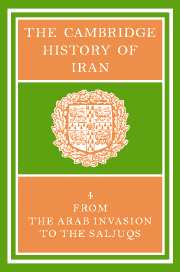Book contents
- Frontmatter
- 1 THE ARAB CONQUEST OF IRAN AND ITS AFTERMATH
- 2 THE ‘ABBĀSID CALIPHATE IN IRAN
- 3 THE ṬĀHIRIDS AND ṢAFFĀRIDS
- 4 The SĀMĀNIDS
- 5 THE EARLY GHAZNAVIDS
- 6 THE MINOR DYNASTIES OF NORTHERN IRAN
- 7 IRAN UNDER THE BŪYIDS
- 8 TRIBES, CITIES AND SOCIAL ORGANIZATION
- 9 THE VISUAL ARTS
- 10 NUMISMATICS
- 11 THE EXACT SCIENCES
- 12 LIFE SCIENCES, ALCHEMY AND MEDICINE
- 13(a) PHILOSOPHY AND COSMOLOGY
- (b) SŪFISM
- 14 THE RELIGIOUS SCIENCES
- 15 SECTS AND HERESIES
- 16 NĀSIR-I KHUSRAU AND IRANIAN ISMĀ‘ĪLĪSM
- 17 ZOROASTRIAN LITERATURE AFTER THE MUSLIM CONQUEST
- 18 ARABIC LITERATURE IN IRAN
- 19 THE RISE OF THE NEW PERSIAN LANGUAGE
- 20 (a) THE “RUBĀ'Ī” IN EARLY PERSIAN LITERATURE
- (b) ‘UMAR KHAYYĀM: ASTRONOMER, MATHEMATICIAN AND POET
- Bibliography
- Index
- Plate section
- Plate section">
- Map 1. Iran under the Abbasids">
- References
8 - TRIBES, CITIES AND SOCIAL ORGANIZATION
Published online by Cambridge University Press: 28 March 2008
- Frontmatter
- 1 THE ARAB CONQUEST OF IRAN AND ITS AFTERMATH
- 2 THE ‘ABBĀSID CALIPHATE IN IRAN
- 3 THE ṬĀHIRIDS AND ṢAFFĀRIDS
- 4 The SĀMĀNIDS
- 5 THE EARLY GHAZNAVIDS
- 6 THE MINOR DYNASTIES OF NORTHERN IRAN
- 7 IRAN UNDER THE BŪYIDS
- 8 TRIBES, CITIES AND SOCIAL ORGANIZATION
- 9 THE VISUAL ARTS
- 10 NUMISMATICS
- 11 THE EXACT SCIENCES
- 12 LIFE SCIENCES, ALCHEMY AND MEDICINE
- 13(a) PHILOSOPHY AND COSMOLOGY
- (b) SŪFISM
- 14 THE RELIGIOUS SCIENCES
- 15 SECTS AND HERESIES
- 16 NĀSIR-I KHUSRAU AND IRANIAN ISMĀ‘ĪLĪSM
- 17 ZOROASTRIAN LITERATURE AFTER THE MUSLIM CONQUEST
- 18 ARABIC LITERATURE IN IRAN
- 19 THE RISE OF THE NEW PERSIAN LANGUAGE
- 20 (a) THE “RUBĀ'Ī” IN EARLY PERSIAN LITERATURE
- (b) ‘UMAR KHAYYĀM: ASTRONOMER, MATHEMATICIAN AND POET
- Bibliography
- Index
- Plate section
- Plate section">
- Map 1. Iran under the Abbasids">
- References
Summary
The problem confronting the writer of this chapter may be summarized in the question: by what process did pre-Islamic Iran turn into the Iran of Islam? Although it is only the social implications of the question which need to be considered here, they are by no means simple. In Iran, as in all the countries of the Near and Middle East, the spoken and written language changed several times over the years, with the practical consequence for modern learning that few scholars are able to study the history of the country continuously from one linguistic period to the others; there are few experts who have a good knowledge of both pre-Islamic and Islamic Iran. Moreover, for pre-Islamic Iran the direct documentary evidence available is unfortunately too meagre to answer all the questions which an Islamicist might in retrospect wish to ask, and even the Arabic documentation which followed the Islamic conquest is, for the first two or three centuries, sadly deficient. The history of the Sāsānian period is often presented with Islamic bias, for the purpose of leading to conclusions which authors of the Islamic period wished to demonstrate, reflecting the conflicts and problems of their times. The same is true of the accounts which they give of the period of the conquests. For these reasons, there are too few substantial studies of the crucial problems of Iranian history during the first centuries after the intervention of Islam for it to be possible to present a synthesis of them. The chapter which follows will therefore consist mainly of somewhat disconnected notes, for the most part of a hypothetical and provisional nature.
- Type
- Chapter
- Information
- The Cambridge History of Iran , pp. 305 - 328Publisher: Cambridge University PressPrint publication year: 1975
References
- 4
- Cited by

